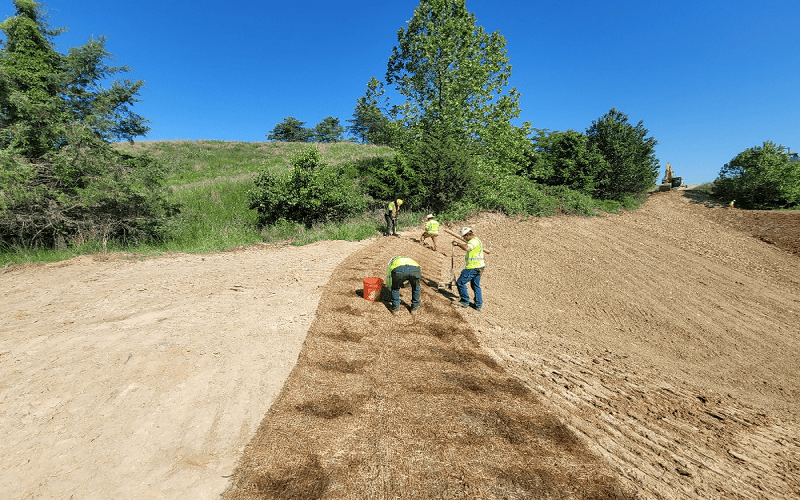In the construction and land management sector, the fight against erosion, and the gradual wearing of soil by external elements such as water, wind, gravity, etc. are of utmost importance. This is critical in the said sector because failure to protect slopes, landscapes, and so on can be detrimental to business operations and may even compromise the lives of many.
This is where an erosion control blanket (ECB) and other geotextile accessories come in. It is a simple yet powerful tool that can give utmost protection against the aforementioned external elements. This write-up delves into the world of erosion control blankets and explores their benefits, applications, and so forth. Read on for details.
Erosion control blankets: a bird’s eye view
An erosion control blanket is a specialized fabric that is made from synthetic or natural materials that are usually laid over the soil to protect it from erosive forces–usually heavy rains. By having a protective layer, the velocity of surface water is effectively and efficiently reduced. This, in turn, can reduce soil displacement and this is the reason why it is particularly effective on steep slopes where the gravitational pull worsens erosion.
Kinds of erosion control blankets
There are basically two kinds of erosion control blankets: biodegradable and synthetic.
Biodegradable
Biodegradable erosion control blankets are usually made from natural materials such as wood fiber, coconut coir, straw, jute, etc. They are specifically designed to become degraded after some time and leave behind a stable solid structure that is complemented by established vegetation.
Synthetic
Synthetic erosion control blankets are usually made from durable synthetic fibers like polypropylene and polyethylene. They offer longer-term erosion support and protection in areas where vegetation establishment is not the primary goal.
Erosion control blankets: the benefits
- Soil stabilization – ECBs are known to provide immediate soil protection and in the process prevent the displacement of topsoil and, in the process, preserve the soil’s structure. This is important when it comes to preventing sedimentation in nearby water bodies, soil fertility, and so forth.
- Vegetation support – By creating a microclimate that is favorable for seed germination as well as growth, ECBs assist in the establishment of vegetation. This cover becomes a long-term solution that can combat erosion.
- Water quality improvement – By cutting down sediment runoff into rivers, streams, and lakes, ECBs preserve water quality. This is essential for aquatic ecosystems as well as human consumption.
- Cost-efficiency – Compared to concrete barriers and other engineering solutions, ECBs and other geotextile materials offer a cost-efficient method for erosion control. Their natural appeal and capacity to be easily integrated into an environment makes them a versatile accessory for various projects.
- Reduced run-off and sediment transport – If properly installed, ECBs can reduce the probability of soil erosion and, at the same time, prevent toxic sediments from polluting waterways.
- Preserve water quality – By cutting down sediments from running off into streams, lakes, rivers, and other bodies of water, water quality is effectively and efficiently preserved. This is essential for human consumption and aquatic ecosystems.
Erosion control blankets: the applications
- Slope protection – ECBs–if properly installed in highway embankments, residential developments, and landscaping projects–can prevent erosion that is caused by prolonged rains.
- Construction site safety – ECBs are often placed in areas where there is disturbed soil. This, in an effort to prevent sediment runoff to the point when the construction tasks are completed.
- Post-fire rehabilitation – ECBs are utilized to stabilize soil in burn areas after wildfires. Such measure is done to prevent mudslides and other natural disasters.
- Riverbank and streambank stabilization – ECBs can protect waterways from erosion that is usually caused by currents, stormwater, waves, and so on.
- Landfill cover – ECBs can provide temporary or permanent cover for landfills. If properly placed, they can control erosion and windblown debris.
Erosion control blankets: choosing the right one
Choosing the right ECB depends on a number of factors. Read on for details.
- Slope steepness – In general, steeper slopes require ECBs that are backed by higher tensile strength as well as superb anchoring capabilities.
- Soil type – Soils with sandy attributes require stronger geotextile blankets than those with clay qualities.
- Rainfall intensity – Places that have heavy rainfall need ECBs with enhanced permeability, water absorption, etc.
- Biodegradability – If long-term soil protection is not necessary, it is best to opt for biodegradable blankets that break down naturally into the environment without causing any harm.
- Cost – Before investing, it is best to compare different materials and features within one’s budget.
Summing up
Erosion control blankets and other geotextile accessories seem like simple and unnecessary materials solutions, but it should be noted that their impact is significant in more ways than one. Therefore, by understanding their benefits, applications, and so forth, choosing the right ones based on needs, protection capabilities, applications, and operations in construction as well as land management areas, can be easy and hassle-free.

